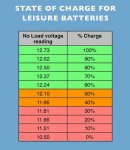whitevanwoman
Guest
I am running a split charge system +2x 115 a LB and the gauge never shows more than 12.6 when fully charged at rest.It reads 14v when van is running but settles to about 12.6 after a few hours with no load and van standing.The answers to how low a reading can be are very varied? Any final answers?
My display unit reads 0.1v lower than the actual battery voltage, so double check your battery level using a multi meter direct off the terminals. There may be a voltage drop because of long thin wires.
I've found varied answers too about what is the lowest safe level so I stick to 11.9 as my very lowest when not under load and try to make sure that the battery is recharged asap, if not enough solar the next day to do this then I run engine or go for a short drive to get it back up. A friend lets his go to 10.5 but not sure how long his batteries last for if regularly discharged that low. Under load from TV it can drop to about 11.5 which, when TV is switched off, bounces back up to about 11.9v. At 11.5 I turn TV off and read a book! This only happens very occasionally during Dec and Jan. I often just run the engine for 20 mins to warm up van and reduce condensation.

